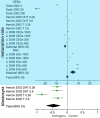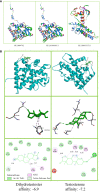A meta-analysis: Effect of androgens on reproduction in sows
- PMID: 36843577
- PMCID: PMC9950266
- DOI: 10.3389/fendo.2023.1094466
A meta-analysis: Effect of androgens on reproduction in sows
Abstract
Introduction: The mechanisms by which male hormones affect the development of ovaries and follicles has been studied by injecting exogenous androgens into sows. This may provide a reference for human polycystic ovary syndrome (PCOS), and can also provide guidance for improving the litter size of sows.
Methods: We present a meta-analysis of studies published in the past 30 years on the effect of androgens on the ovulation rate of sows. A total of 517 papers were analyzed.
Results: The results showed that both testosterone (T) and dihydrotestosterone (DHT) injected into sows were positively related to the ovulation rate. T did not have a relevant effect on swine in vivo blastocyst survival rate. DHT had a negative phase with respect to blastocyst survival rate. Pig T-androgen receiver affinity was higher than the analogous affinity for DHT; this is different in humans. This suggests that sows are not suitable as human PCOS experimental animal models.
Discussion: To improve the litter size of sows, future research should focus on the mixed use of T and DHT, and the timing of use should be consistent with the periodic changes in androgen levels in sows. In addition, the welfare of experimental sows should be considered with reference to the clinical symptoms of PCOS.
Keywords: dihydrotestosterone; oocyte; ovulation; swine; testosterone.
Copyright © 2023 Guo, Lv, Liu, Ma and Radovic.
Conflict of interest statement
The authors declare that the research was conducted in the absence of any commercial or financial relationships that could be construed as a potential conflict of interest.
Figures





Similar articles
-
Androgens in female pig reproduction: actions mediated by the androgen receptor.Soc Reprod Fertil Suppl. 2006;62:55-67. Soc Reprod Fertil Suppl. 2006. PMID: 16866309 Review.
-
AMERICAN ASSOCIATION OF CLINICAL ENDOCRINOLOGISTS, AMERICAN COLLEGE OF ENDOCRINOLOGY, AND ANDROGEN EXCESS AND PCOS SOCIETY DISEASE STATE CLINICAL REVIEW: GUIDE TO THE BEST PRACTICES IN THE EVALUATION AND TREATMENT OF POLYCYSTIC OVARY SYNDROME--PART 1.Endocr Pract. 2015 Nov;21(11):1291-300. doi: 10.4158/EP15748.DSC. Endocr Pract. 2015. PMID: 26509855
-
The polycystic ovary syndrome-associated gene Yap1 is regulated by gonadotropins and sex steroid hormones in hyperandrogenism-induced oligo-ovulation in mouse.Mol Hum Reprod. 2017 Oct 1;23(10):698-707. doi: 10.1093/molehr/gax046. Mol Hum Reprod. 2017. PMID: 28961951
-
Neuroendocrine androgen action is a key extraovarian mediator in the development of polycystic ovary syndrome.Proc Natl Acad Sci U S A. 2017 Apr 18;114(16):E3334-E3343. doi: 10.1073/pnas.1616467114. Epub 2017 Mar 20. Proc Natl Acad Sci U S A. 2017. PMID: 28320971 Free PMC article.
-
Animal models for study of polycystic ovaries and ovarian atresia.Adv Exp Med Biol. 1987;219:237-57. doi: 10.1007/978-1-4684-5395-9_12. Adv Exp Med Biol. 1987. PMID: 2963503 Review.
Cited by
-
Effect of SNPs on Litter Size in Swine.Curr Issues Mol Biol. 2024 Jun 24;46(7):6328-6345. doi: 10.3390/cimb46070378. Curr Issues Mol Biol. 2024. PMID: 39057020 Free PMC article.
-
Network Meta-Analysis: Effect of Cold Stress on the Gene Expression of Swine Adipocytes ATGL, CIDEA, UCP2, and UCP3.Curr Issues Mol Biol. 2024 Apr 25;46(5):3866-3876. doi: 10.3390/cimb46050240. Curr Issues Mol Biol. 2024. PMID: 38785508 Free PMC article.
References
-
- Pereira K, Cote PL, Cantin L, Blanchet J, Labrie F, Breton R. Comparison of crystal structures of human androgen receptor ligand-binding domain complexed with various agonists reveals molecular determinants responsible for binding affinity. Protein Sci (2006) 15:987–99. doi: 10.1110/ps.051905906 - DOI - PMC - PubMed
Publication types
MeSH terms
Substances
LinkOut - more resources
Full Text Sources
Medical
Miscellaneous

